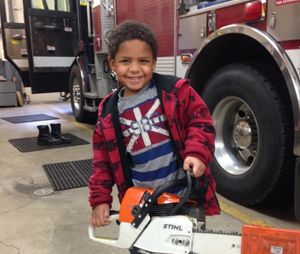When paramedic and EMS Chief Mark Stevens heads home after a long day at Tualatin Valley Fire & Rescue, he sometimes finds it hard to leave the job behind.
It’s not that Stevens is obsessed with light and sirens; to the contrary, the 56-year-old is an outdoors kind of guy who takes advantage of western Oregon’s woodsy landscape to reboot his psyche every chance he gets.
It’s just that Stevens’ family is very much into rescue.
Take Elijah, Stevens’ five-year-old son. He wants to be a firefighter when he grows up. Six weeks ago is when Elijah decided he was grown up. To mark the occasion, he discharged a full fire extinguisher in his family’s kitchen. That would have been heroic instead of merely precocious had there been a fire.
Then there’s Crash, the family’s 75-pound German Shepherd Dog – another natural rescuer, according to Stevens.
“He once got out of his pen at the vet while boarding and let several dogs out of their cages,” says TVF&R’s EMS chief. “Now they take extra precautions when he’s there.”
Stevens’ wife, Jan, is no stranger to rescue either. Now a pastor working on her doctorate, Jan was an emergency department tech for six years at one of the hospitals Stevens frequented.
“I used to bring her patients,” Stevens recalls. “It was good to see her in the middle of a night shift.”
Always there for each other
Stevens and Jan grew to rely on each other not only as husband and wife, but as co-counselors.
“We debrief each other,” Stevens says. “She’s been in a lot of the same situations I’ve been, like when she had an abused baby die in her arms. We talked that through.
“She’s always been there for me, too. A lot of times it’s just listening, but she also reminds me to be good to myself.”
Jan was there following a pediatric code Stevens ran shortly after the birth of their first child.
“It was at a motel. The baby was sleeping between the parents. They just woke up and found him not breathing.
“It was like looking at my own daughter lying there. All the SIDS cases before that were kind of a blur, but that one really registered.”
Calls like that sometimes lead Stevens and Jan to examine core values.
“We do go back and forth on cardiac arrests,” says Stevens. “Some people have mixed feelings about those kinds of cases. I do my job and try to get them back, regardless, but maybe they have a better place to go.”
Saving accounts
Mark is thankful sudden cardiac arrest doesn’t carry the death sentence it did when he started in EMS 37 years ago.
“The survival rate now is just phenomenal,” Stevens says. “Early compressions and defibrillation are making a huge difference, at least around here. A lot of that has to do with our partners in law enforcement.
“Last year we had a code where there were four police cars on scene by the time I got there. Each of the officers had brought AEDs into the house and the family had started CPR even before the officers arrived.”
Another save was just down the street from where Stevens lives.
“I was involved in getting an AED donated to the library in our town. A few years later I was called to that address for an elderly male not breathing. Turns out one of the librarians shocked the patient with that same AED right before we got there. I see that guy from time to time at the library.”
Not in Kansas anymore
Stevens was 19 when he became an EMT in Hays, Kansas.
“I was in a pre-veterinarian program at Fort Hays State University when I got my first EMT card. I loved it. I worked at the local ambulance service for a year and a half, then got into what they called the ‘Emergency Mobile Intensive Care Technician’ course at University of Kansas Medical Center. That was just a fancy name for what turned out to be their paramedic program.
“I had a job as a lab tech to help pay for college, but I didn’t like sitting on a bench looking at pee and blood all day. Getting out into the field was much more what I was wired to do.”
Stevens, who was already married to Jan, found work as a medic in Oregon, Jan’s home state.
“In 1980 I started riding at Buck Medical Services – at the time, the largest private ambulance in the Northwest. After three years I became their director of training.”
That was the beginning of Stevens’ parallel career as an educator. To earn extra cash, he joined the EMS faculties of Oregon Health Sciences University and Mt. Hood Community College. He even taught CPR Instructor and EMT classes at local high schools.
“It felt good to be showing somebody how to save a life,” Stevens says. “You try to pass along whatever you’ve learned in the field in addition to what’s in the textbooks.
“Now I’m teaching the kids of some of my earliest students. It’s very gratifying.”
Patient assessment lessons learned
As an educator and caregiver, Stevens puts patient assessment at the top of his list of street skills that should be stressed.
“I remember this lady who was hanging upside down from her seatbelt at an MVA. I was doing my ABCs and asked her if she could wiggle her fingers and toes. She tells me, ‘I can’t move my feet.’ I’m thinking, great, here’s one of my first calls and my patient is paralyzed. Well, she must have seen the look on my face, because she says to me, ‘I was a paraplegic before the crash.’
 |
| Elijah, Stevens’ five-year-old son. |
“I tell my students that was good to know, but it doesn’t mean she didn’t have an injury. You have to be curious. You only find what you look for.”
No place like home
As retirement approaches for Mark, the only thing he’s sure of is that raising his family will still be priority number one. With seven children – five of them adopted boys between the ages of one and 12 – he’s not worried about keeping busy. And in case he misses rescue, there’s always Elijah, who’s been known to enter the house with a fully charged garden hose.
“The other day he wrapped an extension cord around his two-year-old brother to do some kind of hoisting,” says Mark. “He’s a blast.”
A few more like Elijah and the family can start their own fire department.













